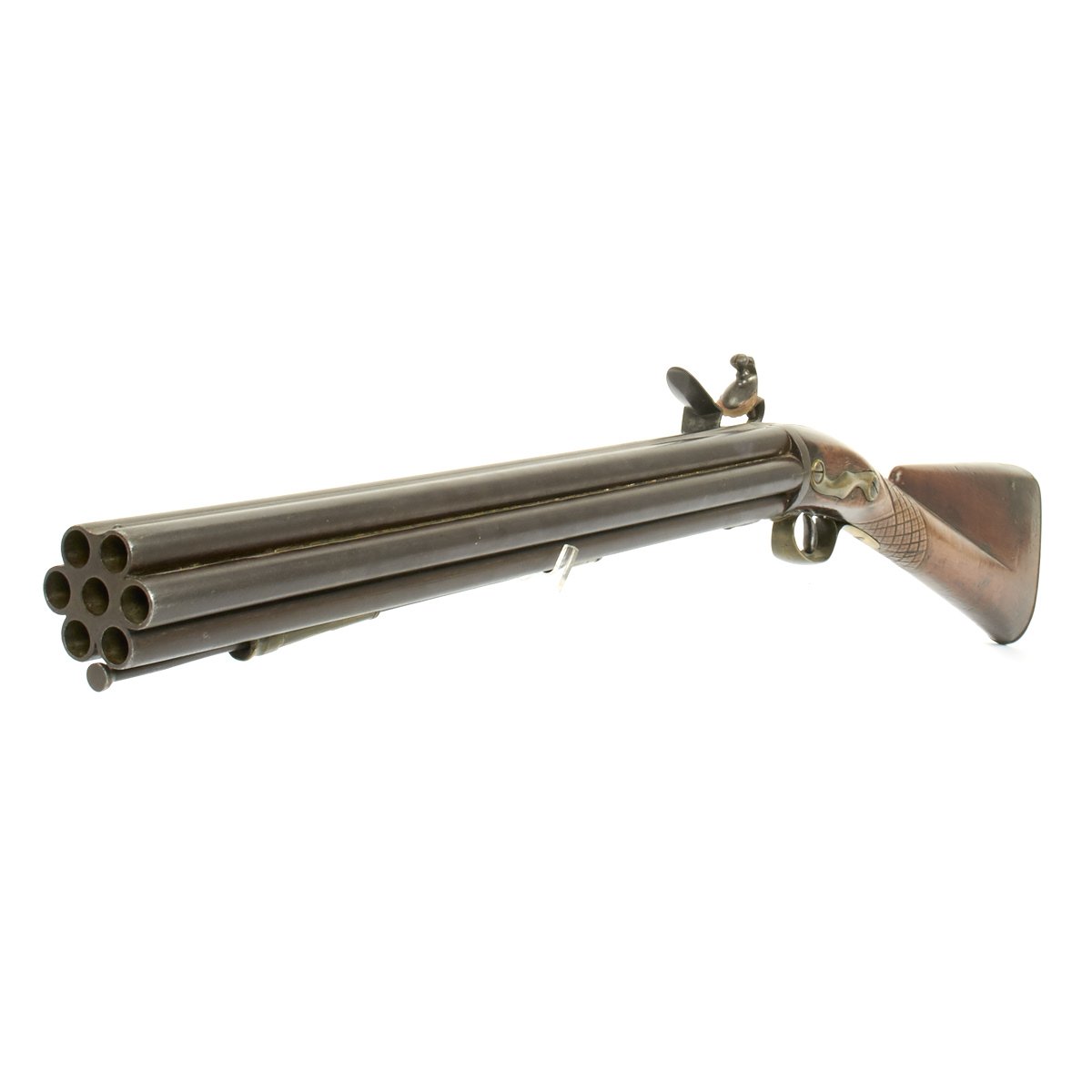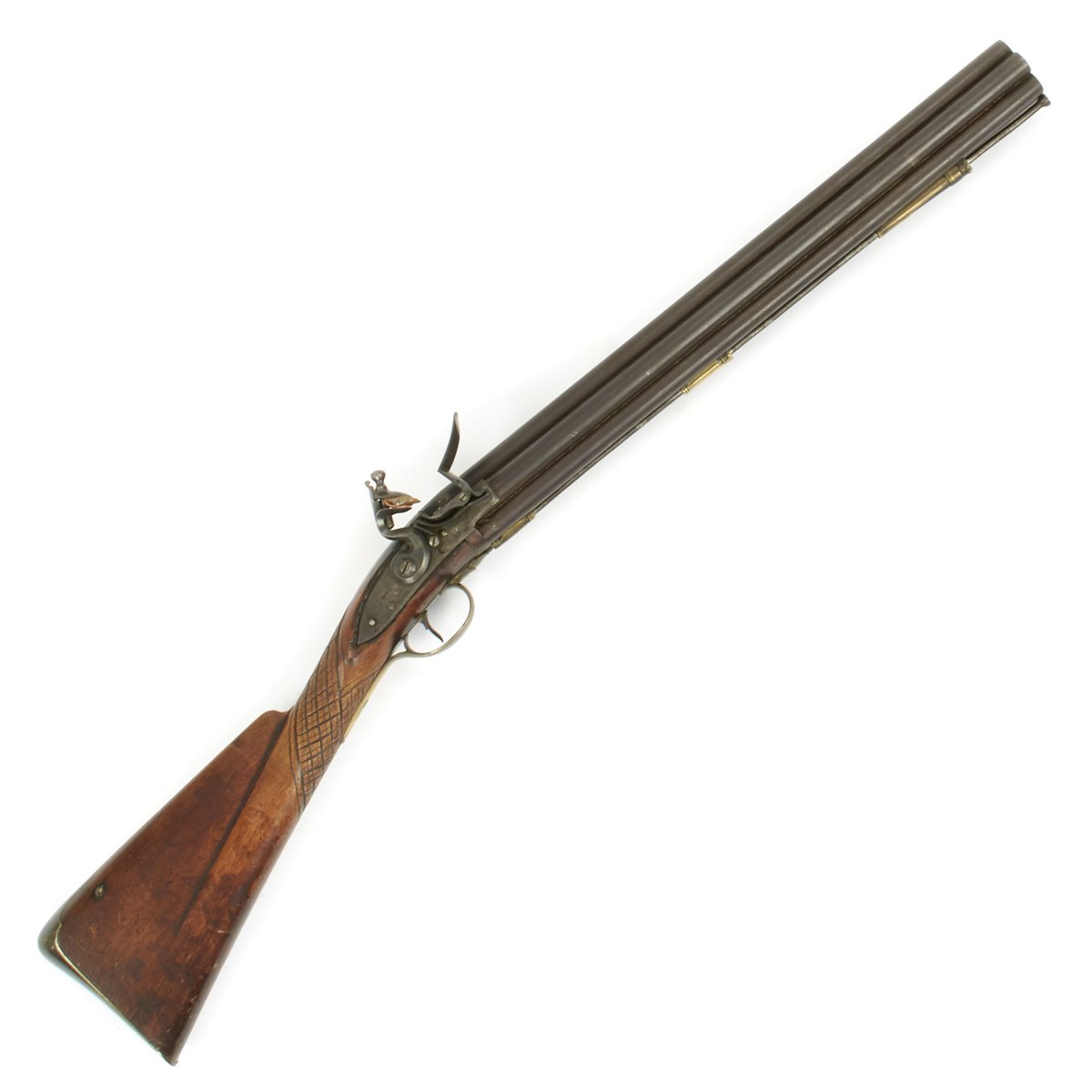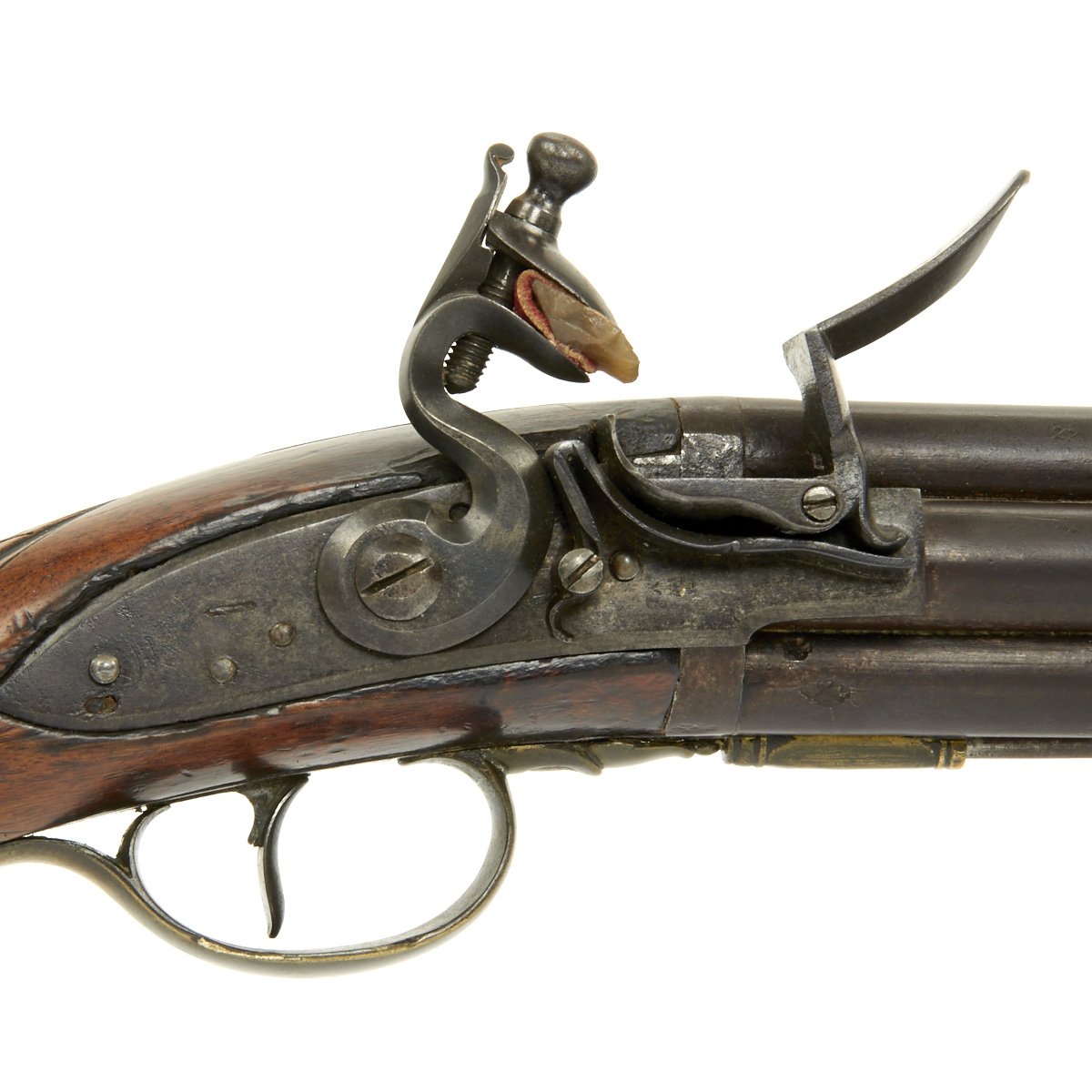Original British Royal Navy Nock Volley Gun Circa 1780 – Princeton Battlefield Museum Original Items
$ 34.995,00 $ 8.748,75
Original Item: One-of-a-kind. IMA has acquired a collection of authentic American Revolutionary War weapons which, for the past 20 years, have been on display at the Princeton Battlefield State Park Clarke House Museum located in Princeton, New Jersey. This Nock Volley Gun was part of that renowned collection.
In 1780 the British Ordnance received a total of 526 naval Volley guns which were made by Henry Nock, a London gunmaker who supplied weapons to the Ordnance from 1773 until 1806. These firearms were then termed “Lord Nelson” or “Crow’s Nest” guns and were designed to fire seven barrels at one time from the upper rigging of ships in combat.
The locks on these weapons had a 5 1/2 inch by 1 inch back action lock mechanism. The lockplates and gooseneck cocks had flat beveled surfaces and the frizzen spring was placed in a vertical position. The locks were marked with a British ownership mark of a crown over a broad arrow. The barrel assembly consisted of a group of six, 19 13/16 inch long, .52 caliber barrels, grouped around a seventh center barrel. The vent arrangement allowed all barrels to fire at once. The breech end of each barrel is marked with a crown above crossed scepters and three ramrod guides hold the steel ramrod. In 1787 another one hundred of these guns were produced for the Ordnance. Those firearms were fitted with conventional lock mechanisms and are readily distinguishable from the Revolutionary War era model.
This weapon is an extremely rare example of a 1780 contract Nock Volley Gun. It conforms in every aspect to the description given above. Considering the small number of these weapons initially made it is a great rarity to have this unique firearm in such an excellent condition. At sometime in the past the wrist area of the stock was checkered. There is also a faint H. NOCK marking just forward of the lock on the barrel.
This Nock gun was featured in the book Muskets of the Revolution and the French & Indian Wars by Bill Ahearn on pages 94-95. A photograph of this firearm appeared in the May 1994 issue of The Gun Report, in an article entitled, “Colonial Firearms Displayed at the Princeton Battlefield”. This weapon was previously on display at the Thomas Clarke House, in the Princeton Battlefield State Park of New Jersey, in a special exhibit called, “Arms of the Revolution”.
The Nock gun was a seven-barrel flintlock smoothbore firearm used by the Royal Navy during the early stages of the Napoleonic Wars. It is a type of volley gun adapted for ship-to-ship fighting, but was limited in its use because of the powerful recoil and eventually discontinued.
Watch Alex evaluate and fire a second model Nock Gun on History Channel’s Pawn Stars!
History and design:
The weapon was invented by British engineer James Wilson in 1779, and named after Henry Nock, the London-based gun maker contracted to build the gun. It was intended to be fired from the rigging of Royal Navy warships onto the deck in the event that the ship was boarded by enemy sailors. Theoretically, the simultaneous discharge of seven barrels would have devastating effect on the tightly packed groups of enemy sailors.
The volley gun consisted of seven barrels welded together, with small vents drilled through from the central barrel to the other six barrels clustered around it. The central barrel screwed onto a hollow spigot which formed the chamber and was connected to the vent.
The gun operated using a standard flintlock mechanism, with the priming gunpowder igniting the central charge via a small vent. When the flash reached the central chamber, all seven charges ignited at once, firing more or less simultaneously.
The first models featured rifled barrels, but this made loading a long and cumbersome process, resulting in all following models being manufactured with smoothbore barrels.
Deployment and use:
During the early stages of the Napoleonic Wars, 500 Nock guns were purchased by the Royal Navy. However, attempts to use the gun during combat quickly revealed design flaws. The recoil caused by all seven barrels firing at once was more powerful than had been thought, and frequently injured or broke the shoulder of whoever was firing the gun, and in any case made the gun very difficult to aim and control. Furthermore, officers were reluctant to issue the guns during battle out of fear that the discharge flames would set fire to the surrounding rigging and sails. The few models purchased by the Royal Navy were removed from service in 1804.
Examples are available for public viewing reside at the York Castle Museum, the Hollywood Guns exhibit at the National Firearms Museum, the Royal Armouries Museum, and the Charleston Museum in South Carolina.
Production Life:
The gun was placed into production with the well-known firm of Henry Nock of London in 1780, and by 1787 a total of 608 were manufactured in at least two different series. Part flame-thrower, part sawed-off shotgun, all crazy, the Nock never gained widespread acceptance.
Popular culture
The Nock gun was brought to modern attention in the 1960 film The Alamo in which one is used by actor Richard Widmark, playing Jim Bowie. Th gun used in the film is now in the National Firearms Museum. In Bernard Cornwell’s series of historical novels featuring fictional British soldier Richard Sharpe and, more recently, in the Sharpe TV series, Nock guns are used by Sharpe himself, the character Patrick Harper (a strong, burly man), and Royal Navy crewmen.
Specifications:
Year of Manufacture: circa 1780
Caliber: about .53″ – 7 barrels
Ammunition Type: Lead Ball / Shot & Powder
Barrel Length: 20 inches
Overall Length: 37 inches
Action: Flintlock Side Action
Feed System: Muzzle-Loaded
NOTE: International orders of antique firearms MUST be shipped using UPS WW Services (courier). USPS Priority Mail international will not accept these.
Fast Shipping with Professional Packaging
Thanks to our longstanding association with UPS FedEx DHL, and other major international carriers, we are able to provide a range of shipping options. Our warehouse staff is expertly trained and will wrap your products according to our exact and precise specifications. Prior to shipping, your goods will be thoroughly examined and securely secured. We ship to thousands clients each day across multiple countries. This shows how we're dedicated to be the largest retailer on the internet. Warehouses and distribution centres can be located throughout Europe as well as the USA.
Note: Orders with more than one item will be assigned a processing date depending on the item.
Before shipping before shipping, we'll conduct a thorough inspection of the items you have ordered. Today, the majority of orders will be delivered within 48 hours. The delivery time will be between 3-7 days.
Returns
The stock is dynamic and we cannot completely manage it because multiple stakeholders are involved, including our factory and warehouse. So the actual stock may alter at any time. It's possible that you may not receive your order once the order has been made.
Our policy is valid for a period of 30 days. If you don't receive the product within 30 days, we are not able to issue a refund or an exchange.
You can only return an item if it is unused and in the same state as the day you received it. You must have the item in its original packaging.
Related products
Uncategorized
Uncategorized
Uncategorized
Uncategorized
Uncategorized
Uncategorized
Australian WWII Owen MK1 Machine Carbine SMG Custom Fabricated Replica with Sling Original Items
Uncategorized
Uncategorized
Uncategorized
Uncategorized
Uncategorized
Uncategorized
Angolan Rebel 1970s era 60mm Inert Display Mortar from Angolan Civil War Original Items
Uncategorized
Uncategorized
Uncategorized
Uncategorized
Uncategorized
Band of Brothers ORIGINAL GERMAN WWII Le. F.H. 18 10.5cm ARTILLERY PIECE Original Items
Uncategorized













































































